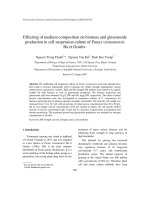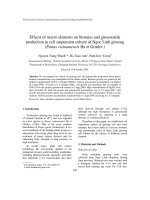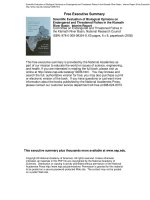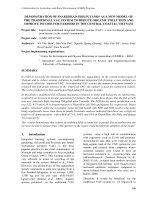Impacts of integrated farming system on socio-economics and livelihood sustainability of small and marginal farmers in Chhattisgarh
Bạn đang xem bản rút gọn của tài liệu. Xem và tải ngay bản đầy đủ của tài liệu tại đây (304.08 KB, 8 trang )
Int.J.Curr.Microbiol.App.Sci (2019) 8(4): 822-829
International Journal of Current Microbiology and Applied Sciences
ISSN: 2319-7706 Volume 8 Number 04 (2019)
Journal homepage:
Original Research Article
/>
Impacts of Integrated Farming System on Socio-economics and Livelihood
Sustainability of Small and Marginal Farmers in Chhattisgarh
Anil Kumar Netam1*, Birbal Sahu2 and Chainu Ram Netam3
1
AICRP on IFS – On Farm Research, IGKV, Krishi Vigyan Kendra, Kanker,
Chhattisgarh, India
2
Krishi Vigyan Kendra, Kanker, Chhattisgarh, India
3
College of Agriculture & Research Station, Bemetara, Chhattisgarh, India
*Corresponding author
ABSTRACT
Keywords
Integrated farming
system, Production,
Socio-economics,
Livelihood,
employment,
Resource recycling
Article Info
Accepted:
07 March 2019
Available Online:
10 April 2019
The integrated farming system study was conducted at farmers field of village –Mohpur, BlockKanker, District- Uttar Bastar Kanker (C.G.) under All India Coordinated Research Project on
Integrated Farming System- On Farm Research, Indira Gandhi Krishi Vishwavidyalaya, Krishi
Vigyan Kendra, Kanker during July, 2017- June, 2018 for finding the contribution of total
income to the livelihood of farmers who practices integrated farming system. Study was
conducted in crop + vegetable + dairy + Goatry + piggery + poultry + duck + fisheries + lac
cultivation + minor forest produce + FYM & vermi-compost + Azolla production farming
system in 1.0 hectare area under irrigated condition. Out of one hectare area, 0.606 ha was
allotted for crop component i.e field crops (rice, blackgram, pigeon pea, sweet corn) &
vegetables (tomato, brinjal, onion, potato, peas, chilly, cucubits etc), 0.2 ha for lac cultivation,
0.13 ha for fisheries, 0.006 ha for organic manure production, 0.03 ha for animal husbandry &
poultry and 0.03 ha for residency & other. Growing field crops and vegetables with 60 percent
area in order to meet the family food requirement and in addition to get better profit out of these
produce. The results of one year study of integrated farming system indicated that the economic
yield was 244.69 q with the highest been contributed by vegetables (116.52 q), followed by
organic manure (87.65 q), field crops (30.80), animal husbandry (2.85 q), minor forest produce
(2.80 q), Azolla production (1.44 q), lac cultivation (1.40 q), fisheries (0.70 q) and poultry (0.53
q). Similarly annual total net return of the IFS model was Rs. 217591.00 with the highest been
contributed by vegetables (Rs. 101860), followed by field crops (Rs. 34067), organic manure
production (Rs. 24130), lac cultivation (Rs. 17440), animal husbandry (Rs. 17010), poultry (Rs.
14530) minor forest produce (Rs. 5630), fisheries (Rs.4700) and Azolla (Rs. 1584). Effective
recycling of farm by products and waste in terms of FYM (46.4 q), vermicompost (32 q), goat
manure (7.6 q) and poultry manure (1.65 q) and can save Rs. 30150.00 per year. The total
annual mandays generated for family members by IFS model was 619 and highest been
contributed by vegetable production (265 mandays) followed by animal husbandry (108
mandays). Thus, we can conclude that adoption of integrated farming systems improves the
profitability and achieve sustainable production by effective recycling of natural resource in
addition to meeting family needs.
822
Int.J.Curr.Microbiol.App.Sci (2019) 8(4): 822-829
therefore assumes greater importance for
sound management of farm resources to
enhance the farm productivity and reduce the
environmental degradation, improve the
quality of life of resource poor farmers and
maintain sustainability. In order to sustain a
positive growth rate in agriculture, a holistic
approach is the need of the hour. Farming
system is a mix of farm enterprises in which
farm families allocate resources for efficient
utilization of the existing enterprises for
enhancing productivity and profitability of the
farm (Varughese et al., 2009). Integrated
farming system approach is not only a reliable
way of obtaining fairly high productivity with
considerable scope for resource recycling, but
also concept of ecological soundness leading
to sustainable agriculture. One of the option
to evaluate the potential of age- old mixed
farming now as a IFS in enhancing income of
farm families within the reasonable time
period.
Introduction
Agriculture has always been considered as the
back- bone of our country. In India 70 % of
rural population is engaged in agriculture and
80% of population live, directly or indirectly
on income delivered from agriculture. There
are 115 million operational holdings in the
country and about 80 % are marginal and
small farmers (Manjunatha et al., 2014). To
fulfill the basic needs of house hold including
food (cereal, pulses, oilseeds, milk, fruit,
honey, meat, etc.), feed, fodder, fiber, etc.
warrant an attention about Integrated Farming
System. Undoubtedly, majority of the farmers
are doing farming since long back but their
main focus was individual components but
not in a integrated manner. At the ICAR and
State Agricultural Universities level, lot of
efforts have been made aiming at increasing
the productivity of different components of
farming system i.e. crops, horticultural crops,
live stock (dairy, goatry, piggery), poultry
(chicken, ducks, quail, pigeons), lac
cultivation, apiculture, sericulture, mushroom
cultivation, organic manures production, biogas etc. individually but lacking in their
integration by following farming system
approach. The integration is made in such a
way that product of one component should be
the input for other enterprises with high
degree of complimentary effects on each
other.
Materials and Methods
The integrated farming system study was
conducted at farmers field of village –
Mohpur, Block- Kanker, District- Uttar Bastar
Kanker (C.G.) under All India Coordinated
Research Project on Integrated Farming
System- On Farm Research, Indira Gandhi
Krishi Vishwavidyalaya, Krishi Vigyan
Kendra, Kanker during July, 2017- June, 2018
for finding the contribution of total income to
the livelihood of farmers who practices
integrated farming system. Study was
conducted in field crops + vegetable + dairy +
Goatry + piggery + poultry + duck + fisheries
+ lac cultivation + minor forest produce +
FYM & vermi-compost + Azolla production
farming system in 1.0 hectare area under
irrigated condition. Topography of soil was
upland and midland with sandy loam soil. Out
of one hectare area, 0.606 ha was allotted for
crop component i.e. field crops (rice,
blackgram, pigeon pea, sweet corn) &
The operational farm holding in India is
declining and over 85 million out of 115
million are below the size of 1 ha
(Manjunatha et al., 2014). Due to ever
increasing population and decline in per
capita availability of land in the country,
practically there is no scope for horizontal
expansion of land for agriculture. Only
vertical expansion is possible by integrating
farming components requiring lesser space
and time and ensuring reasonable returns to
farm families. The Integrated Farming System
823
Int.J.Curr.Microbiol.App.Sci (2019) 8(4): 822-829
vegetables (tomato, brinjal, onion, potato,
peas, chilly, cucubits etc), 0.2 ha was taken
for lac cultivation, 0.13 ha for fisheries, 0.006
ha for organic manure production, 0.03 ha
animal & poultry and 0.03 ha for residency.
Total gross cropped area was 1.51 ha wherein
under vegetables (0.91 ha) and field crops
(0.6 ha). Technical and some physical inputs
of agriculture are given to farmer during the
study period. All the activities regarding
farming i.e. crops cultivation, livestock
rearing, poultry, fish culture, lac cultivation,
organic manures and Azolla production,
minor forest produce collection, homestead
components and spent time of family
members recorded every day in data register
by household members and the data were also
recorded personally by the researcher by
visiting the study area and interviewing the
family members. All possible efforts were
made to ensure the collection of reasonably
accurate data from the farm household
through face- to- face interview and recall
basis.
(dairy, goatry, piggery), poultry (back yard
poultry, ducks, pigeons), fisheries, lac
cultivation, minor forest produce and organic
manures production recorded annual total
gross return of the IFS model was Rs.
347103.00 (Table 5) with the highest been
contributed by vegetables (Rs. 165540),
followed by field crops (Rs. 55199), organic
manure production (Rs. 30150), animal
husbandry (Rs. 28550), lac cultivation (Rs.
25200), poultry (Rs. 19210), minor forest
produce (Rs. 10430), fisheries (Rs. 9800) and
Azolla production (Rs. 3024). Integration of
farm enterprises generated additional gross
income Rs. 126364.00 per annum where in
comparison to Rs. 220739.00 by field and
vegetable crops.
Annual total net return of the IFS model was
Rs. 217591.00 with the highest been
contributed by vegetables (Rs. 101860),
followed by field crops (Rs. 34067), organic
manure production (Rs. 24130), lac
cultivation (Rs. 17440), animal husbandry
(Rs. 17010), poultry (Rs. 14530), minor forest
produce (Rs. 5630), fisheries (Rs.4700) and
Azolla (Rs. 1584). Integration of different
farm enterprises generated additional net
income Rs. 81664.00 per annum where in
comparison to Rs. 135927.00 by field and
vegetable crops. Average B: C ratio of the
farming system was 2.69 and highest was
under organic manure production (5.01)
followed by poultry (4.10), lac cultivation
(3.25), field crops production (2.61),
vegetables production (2.60), minor forest
produce (2.17), Azolla production (2.10),
animal husbandry (1.96) and fisheries (1.92).
Kumara et al., (2017) also found that
inclusion of enterprises in integrated farming
system in 1 ha area gave average net returns
of Rs. 186571.00 per annum with the highest
been contributed by dairy (Rs. 47378),
horticulture (Rs. 38526), and sheep (Rs.
17876). In Tamilnadu Jayanti et al., (2001)
found that the net return of IFS (Cropping +
Cost of cultivation of every farm enterprises
calculated by sum of internal input cost,
external input cost, labour cost and
transportation cost. Gross returns from farm
produce calculate on the basis of total produce
and sold produce of farm enterprises
separately. Also recorded the by products of
every enterprises of farm and their recycling
pattern within a farm and outside of farm.
Forest trees are also in existing farming
system; therefore data relevant to minor forest
produce collection and income generation
also recorded.
Results and Discussion
Economics of integrated farming system
The data after study indicated that adoption of
integrated farming system by inclusion of
crops based enterprises, animal husbandry
824
Int.J.Curr.Microbiol.App.Sci (2019) 8(4): 822-829
fish + poultry) was on an average of Rs.
97731/ha/year over the arable farming (Rs
36190/ha/year). While in Goa Manjunath et
al., (2003) recorded that the net return of IFS
(Rice-Brinjal (0.5 ha) + Rice- cowpea (0.5 ha)
+ mushroom + poultry) was Rs. 75360.00 per
year over the cashew nut cultivation (Rs.
36330) alone. In Madhya Pradesh Tiwari et
al., (1999) found that the integrated farming
gave a margin in net return of Rs 44913/
ha/year over the arable farming (Rs. 24093).
7170), minor forest produce (3830) and
fisheries (Rs.1620). Integration of farm
enterprises generated additional net income
Rs. 33710.00 per annum where in comparison
to Rs. 111627.00 by field and vegetable
crops.
In Haryana, Singh et al., (1993)
conducted studies of various farming systems
on 1 ha of irrigated and 1.5 ha of unirrigated
land and found that under irrigated conditions
of mixed farming with crossbred cows
yielded the highest net profit (Rs 20,581/-)
followed by mixed farming with buffaloes
(Rs 6,218/-) and lowest in arable farming (Rs
4,615/-). Another study involving cropping,
poultry, pigeon, goat and fishery was
conducted under wetland conditions of Tamil
Nadu conducted by Jayanthi et al., (2001)
three years results revealed that integration of
crop with fish (400 reared in 3 ponds of 0.04
ha each), poultry (20 babkok layer bird),
pigeon (40 pairs), and goat (Tellichery breed
of 20 female and 1 male in 0.03 ha deep litter
system) resulted in higher productivity, higher
economic return of Rs 1, 31,118 (mean of 3
year) (Table 2).
Annual total cost of cultivation of the IFS
model was Rs. 129152.00 and highest was
under vegetables production (Rs. 63680),
followed by field crop production (Rs.
21132), animal husbandry (Rs. 14540), lac
cultivation (Rs. 7760), organic manure
production (Rs. 6020), fisheries (Rs. 5100),
minor forest produce (Rs. 4800), poultry (Rs.
4680) and Azolla production (Rs. 1440).
Integrated farming system (crop + dairy +
horticultural + fishery + mushroom + apiary +
vermicompost) study of 1.0 ha area conducted
at western plain zone of Uttar Pradesh by
Singh et al., and recorded that total cost of
cultivation of IFS model was Rs. 267295.00
per year, gross return Rs. 570705.00 per year
and net return 303410.00 per year. Annual
total gross income of the IFS model on the
basis of sold farm
produce was Rs.
274489.00 with the highest been contributed
by vegetables (Rs. 159265), followed by field
crops (Rs. 37174), animal husbandry (Rs.
25650), lac cultivation (Rs. 25200), poultry
(Rs. 11850), minor forest produce (8630) and
fisheries (Rs.6720). Due to integration of
enterprises with in a farm generated
additional gross income Rs. 78050.00 per
annum on the basis of sold produce as
compare to Rs. 196439.00 by crops only.
Annual total net income of the IFS model on
the basis of sold produce was Rs. 153567.00
and highest was under vegetables production
(Rs. 95585), followed by lac cultivation (Rs.
17440), field crop production (Rs. 16042),
animal husbandry (Rs. 11110), poultry (Rs.
Economic yield of enterprises in integrated
farming system
Annual total economic yield of IFS model
was 244.69 q (Table 4) with the highest been
contributed by vegetables (116.52 q),
followed by organic manure (87.65 q), field
crops (30.80), animal husbandry (2.85 q),
minor forest produce (2.80 q), Azolla
production (1.44 q), lac cultivation (1.40 q),
fisheries (0.70 q) and poultry (0.53 q). Annual
total family consumption of economic yield
of IFS model was 15.75 q and highest was
under field crops (10.85 q), followed by
vegetables (4.04 q), minor forest produce
(0.60 q), animal husbandry produce (0.44 q),
fisheries (0.22 q) and poultry (0.20 q).
Organic manures 87.65 q used for crop
production and Azolla 1.44 q used for feeding
to poultry & pigs at own farm (Table 3).
825
Int.J.Curr.Microbiol.App.Sci (2019) 8(4): 822-829
Table.1 Productivity of farm enterprises in integrated farming system model
Enterprises
Area
(ha)
Economic
yield (q)
Family
consumption
(q)
Sold
(q)
Rs./ q
Gross
return
(Rs.)
Cost of
production
(Rs.)
Net
return
(Rs.)
Straw
(q)
Use of residue
Feed
(q)
Composting
(q)
Family
labour
(Man
days)
B:C
On sold farm
produce (Rs.)
Gross
Net
return return
Field crops
Rice
0.4
18.6
9.5
9.1
1590
29574
12140
17434
16.4
14.8
1.6
48
2.44
14469
2329
Blackgram
0.1
1.05
0.3
0.75
4500
4725
2120
2605
1.47
0.5
0.97
13
2.23
3375
1255
Pigeon pea
0
0.9
0.25
0.65
5000
4500
1480
3020
0.8
0
0.8
6
3.04
3250
1770
Sweet corn
0.1
10.25
0.2
10.05
1600
16400
5392
11008
8
0
8
25
3.04
16080
10688
0.6
30.8
10.25
20.55
0
55199
21132
34067
26.67
15.3
11.37
92
2.61
37174
16042
0.1
12.3
0.9
11.4
2000
24600
7800
16800
2.60
0
2.60
35
3.15
22800
15000
0.006
1.72
0.75
0.97
2000
3440
1260
2180
0.80
0
0.80
9
2.73
1940
680
Tomato
0.2
28.2
0.32
27.88
1000
28200
13900
14300
2.45
0
2.45
59
2.03
27880
13980
Brinjal
0.2
29
0.38
28.62
1000
29000
13600
15400
2.30
0
2.30
53
2.13
28620
15020
Onion & potato
0.1
14.1
0.55
13.55
1500
21150
7600
13550
0.85
0
0.85
27
2.78
20325
12725
Peas
0.1
9.5
0.2
9.3
2500
23750
7400
16350
2.40
0
2.40
29
3.21
23250
15850
Chilly
0.1
8.2
0.09
8.11
3000
24600
8200
16400
1.55
0
1.55
36
3.00
24330
16130
Cucurbits
0.1
13.5
0.85
12.65
800
10800
3920
6880
1.80
0
1.80
17
2.76
10120
6200
0.906
116.52
4.04
112.48
0
165540
63680
101860
14.75
0
14.75
265
2.60
159265
95585
Cow
8
2.2
0.4
1.8
4000
8800
7200
1600
0
0
46.40
60
1.22
7200
0
Goatry
11
0.27
0.02
0.25
45000
12150
5400
6750
0
0
7.60
40
2.25
11250
5850
Pig
3
0.38
0.02
0.36
20000
7600
1940
5660
0
0
0
8
3.92
7200
5260
22
2.85
0.44
2.41
0
28550
14540
14010
0
0
54.00
108
1.96
25650
11110
Poultry
Back yard poultry
46
0.41
0.16
0.25
41000
16810
3940
12870
0
0
1.30
18
4.27
10250
6310
Duck
15
0.12
0.4
0.08
20000
2400
740
1660
0
0
0.38
2
3.24
1600
860
61
0.53
0.20
0.33
0
19210
4680
14530
0
0
1.68
20
4.10
11850
7170
Total
Vegetables
Vegetables
Vegetable. in Badi
Total
Animal husbandry
Total
Total
826
Int.J.Curr.Microbiol.App.Sci (2019) 8(4): 822-829
Table.2 Production and recycling of organic manures in integrated farming system model
Organic manures
Area
(m2)
Production
(q)
Use in
farm (q)
Gross
return
(Rs.)
Cost of
production
(Rs.)
40
8
2
12
62
46.4
7.6
1.65
32
87.65
46.4
7.6
1.65
32
87.65
3250
1000
300
25600
30150
600
120
120
5180
6020
FYM
Goat Manure
Poultry manure
Vermi compost
Total
Net
Family
B:C
return labour
(Rs.) (Man days)
2650
880
180
20420
24130
6
1
1
39
47
5.42
8.33
2.50
4.94
5.01
Table.3 Minor forest produces collection in integrated farming system model
Minor
forest
produces
Mahua
Chironji
Tendu Patta
Total
Tree/
plants
(Nos.)
Production
3
5
2910
2918
2.40 q
0.40 q
1400 bundle
Family
Gross
Cost of
consumption return collection
(Rs.)
(Rs.)
0.60 q
0
0
0.60
7200
1200
2030
10430
Net
Family
return
labour
(Rs.) (Man days)
3600
480
720
4800
3600
720
1310
5630
B:C
30
3
6
39
2.00
2.50
2.82
2.17
Table.4 Farm production, utilization and recycling of produces in integrated farming system
model
Enterprises
Field crops
Vegetables
Animal
husbandry
Poultry
Fisheries
Lac
cultivation
Organic
manures
Azolla
Minor forest
produce
Total
Area
(ha)
0.606
Economic
Family
Sold
Stra
yield (q) consumption/ produce w
use in farm
(q)
yield
(q)
(q)
30.80
10.85
20.55 26.67
Broken
rice &
husk/
other
3.26
Feed
Use (q)
Composting
0.028
116.52
2.85
4.04
0.44
112.48
2.41
14.75
0
0
0
18.5
6
0
0
0.002
0.13
0.20
0.53
0.70
1.40
0.20
0.22
0
0.33
0.48
1.40
0
0
7.80
0
0
0
0
0
0
1.68
0
7.80
0.006
87.65
87.65
0
-
0
-
-
0.001
0n
bunds
0.97
1.44
2.80
1.44
0.60
0
2.20
0
0
0.60
0.60
0
244.69
104.84
139.85
49.22
3.86
19.1
6
89.60
827
11.37
14.75
54.00
Int.J.Curr.Microbiol.App.Sci (2019) 8(4): 822-829
Table.5 Economics and employment generation in integrated farming system model
Enterprises
Cost of
production
(Rs.)
21132
Field crops
63680
Vegetables
14540
Animal husbandry
4680
Poultry
5100
Fisheries
7760
Lac cultivation
6020
Organic manures
1440
Azolla
4800
Minor
forest
produce
Total
129152
Gross
Net
B: C
On sold farm produce
return return ratio Gross return Net return
(Rs.)
(Rs.)
(Rs.)
(Rs.)
55199 34067 2.61
37174
16042
165540 101860 2.60
159265
95585
28550 14010 1.96
25650
11110
19210 14530 4.10
11850
7170
9800
4700
1.92
6720
1620
25200 17440 3.25
25200
17440
30150 24130 5.01
0
-6020
3024
1584
2.10
0
-1440
10430
5630
2.17
8630
3830
347103 217591
2.69
274489
145337
Family labour
(mandays)
92
265
108
20
12
24
47
12
39
619
production. Similar findings also recorded by
Kumara et al., (2017) that the total quantity
(462.50 kg) of organic source of nutrients are
being recycled from farm waste obtained
from different components. More than 35 per
cent of NPK requirement would be met
through recycling of farm wastes in form of
compost and vermi compost within the
system itself. 1.44 q of Azolla produced in
farm was utilized as supplement feed for
poultry and pigs
Resource recycling in integrated farming
system
Annual total straw yield of IFS model was
49.22 q (Table 2) with the highest been
contributed by field crops (26.67 q), followed
by vegetables (14.75) and lac cultivation
(7.80 q). Paddy straw 15.30 q used for feeding
to animals and rest of the farm residues (33.92
q) utilized for compost production. Cow dung
(46.4 q), goat vista (7.6 q) and poultry vista
(1.68 q) of farm used for FYM, goat and
poultry manure production respectively. Total
organic manures production was 87.65 q with
the highest been contributed by FYM (46.4 q)
followed by vermicompost (32 q), goat
manure (7.6 q) and poultry manure (1.65 q)
and the total quantity (87.65 q) of organic
sources of nutrients are being recycled from
farm waste obtained from different
components. Recycling of farm wastes in
form of organic manures within the system
itself was found very economical in saving
Rs. 30150.00 per year as well as save the use
of chemical fertilizers or its substitutes and
also improve the soil health condition, there
by enhanced the organic matter and microbial
activity which resulted in sustainable
Employment generation
farming system
in
integrated
Integrated farming system has created more
number of working hours in the system due to
involvement of more enterprises than
cropping system alone. Total employment
generation of IFS model for family members
was 619 mandays per annum (Table 5) with
the highest been contributed by vegetable
production (265 mandays) followed by animal
husbandry (108 mandays), field crop
production (92 mandays), organic manures
production (47 mandays), minor forest
produce (39 mandays), lac cultivation (24
mandays), fisheries (12 mandays) and Azolla
828
Int.J.Curr.Microbiol.App.Sci (2019) 8(4): 822-829
production (12 mandays). Integration of
enterprises created the additional employment
opportunity i.e. 262 mandays per annum as
compare to only 357 mandays/ annum by
cropping system alone. This has provided
employment opportunity throughout the year
due to involvement of more than one
enterprise in the system. Kumara et al.,(2017)
reported that 1.0 ha model has generated 515
mandays, 760 mandays, 1070 mandays and
932 mandays per hectare per year during
2012-13, 2013-14, 2014-15, 2015-16,
respectively. Jayanthi et al., also found that
integration of enterprises created the
employment
opportunities
where
in
comparison to 369 mandays/year generated in
cropping alone system, cropping with fish and
goat created additional 207 man days/annum.
resource conservation and sustainable
production for small and marginal
farmers. International Journal of Plant
& Soil Science 15 (3): 1-9
Manjunath BL, Itnal CJ.2003. Farming
system options for small and marginal
holdings in different topographies of
Goa. Indian J Agron. 48 (1): 4-8.
Manjunatha S.B., Shivmurthy D., Sunil A
Satyareddi, Nagaraj M.V., Basavesha
K.N. 2014. Integrated Farming System An Holistic Approach: A Review.
Research and Reviews: Journal of
Agriculture and Allied Sciences. 4(3):
30-38.
Singh CB, Renkema JA, Dhaka JP, Singh,
Keran, Schiere, J.B. 1993. Income and
employment on small farmers. In :
Proceeding An International workshop
on Feeding of Ruminants on fibrous
crop residues: Aspects of treatment,
feeding, nutrient evaluation, research
and extension. Karnal, Haryana, 4-8
February, 1991, pp. 67–76.
Tiwari SP, Ravi R, Nandeha KL, Vardia HK,
Sharma RB, and Rajgopal S. 1999.
Augmentation of economic status of
Bastar tribals through integrated (crop,
livestock, poultry, duck, fish) farming
system. Indian J Animal Sci. 69 (6):
448–52.
Varughese K, Mathew T. 2009. Integrated
farming systems for sustainability in
coastal ecosystem. Indian J Agron.
54(2): 120-127.
References
Jayanthi C, Rangasamy A, Mythili S,
Balusamy M, Chinnusamy C, Sankaran
N. 2001. Sustainable productivity and
profitability to integrated farming
systems in low land farms. In: Extended
summaries, pp. 79-81. (Eds: A.K.
Singh, B. Gangwar, Pankaj and P.S.
Pandey), National Symposium on
Farming System Research on New
Millennium, PDCSR, Modipuram.
Kumara
O.,
Sannathimmappa
H.G.,
Basavarajappa, D.N., Danaraddi Vijay
S., Pasha Akmal, Rajani, S.R. 2017.
Integrated Farming System – An
approach towards livelihood security,
How to cite this article:
Anil Kumar Netam, Birbal Sahu and Chainu Ram Netam. 2019. Impacts of Integrated Farming
System on Socio - economics and Livelihood Sustainability of Small and Marginal Farmers in
Chhattisgarh. Int.J.Curr.Microbiol.App.Sci. 8(04): 822-829.
doi: />
829









